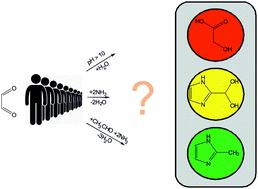The reaction of acetaldehyde, glyoxal, and ammonia to yield 2-methylimidazole: thermodynamic and kinetic analyses of the mechanism†
Abstract
The most thermodynamically and kinetically favorable pathways for the formation of 2-methylimidazole (2MI) in the reaction of glyoxal and acetaldehyde with ammonia in aqueous solution have been determined. The formation of 2MI proceeds through a number of successive intermediates of acyclic and cyclic structures, and the most favorable route (thermodynamically and kinetically) for the formation of the imidazole ring is the condensation of amine intermediates, in contrast to the existing concepts of imine structures. The limiting stage is the stage of cyclization involving the intramolecular attack by the amino group of the precyclic intermediate on the carbon atom bound to the hydroxyl group with the simultaneous release of a water molecule according to the SN2 mechanism. Further stages of stepwise dehydration lead to the formation of a cyclic diazine, the intramolecular migration of the proton of the tertiary carbon atom to the nitrogen atom of which completes the formation of 2MI. Experimental studies on the effect of the order of mixing of initial reagents on the 2MI yield confirmed the quantum-chemically substantiated favorable pathway for the formation of 2MI during the interaction of amine intermediates, and also revealed that the selectivity of the 2MI formation is achieved by successive mixing of acetaldehyde with ammonia until the formation of hydroxyamine products and their further interaction with glyoxal.



 Please wait while we load your content...
Please wait while we load your content...